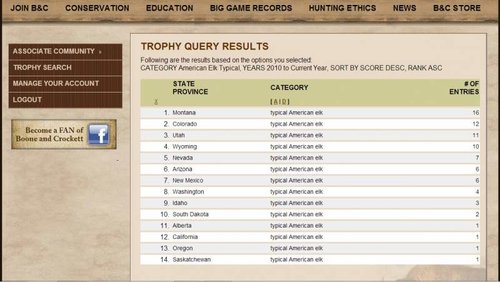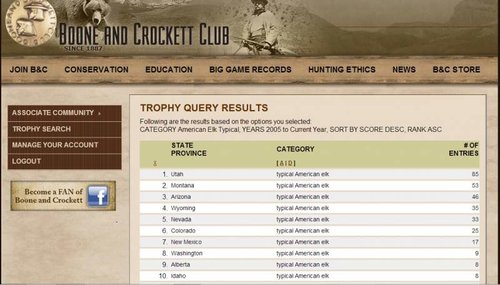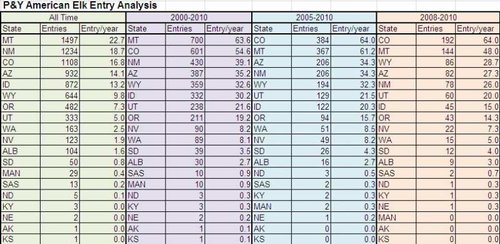Not wanting to start any arguments here, but was bored watching the Oregon/K-State game last night, so decided to do some research of what kind of bulls have been coming from the western states over the last few years.
I subscribe to the Boone and Crockett Trophy Search database. It allows you to search their database for just about anything you want to know about animals, scores, measurements, locations, hunter, etc.
I did a query to see what the typical elk entries looked like over the last three years, 2010 to 2012 (probably not many 2012 elk yet scored and entered). And the last eight year, 2005-2012. Somethings were surprising, some not surprising.
Here is 2010-2012:

Interesting to see that two states with the most entries in this period, Montana and Colorado, are mostly known by the research services as "opportunity states." I hunt both of them and I have never had a shot at a B&C bull, but it is interesting to see that you can combine large amounts of opportunity with some level of quality.
No state sells more elk tags than Colorado. I am sure most of these entries come from limited areas. Yet, it shows Colorado is balancing the demand by some that the shoot more elk, that they continue to have lots of non-residents coming to small towns in hunting seasons, with the demand that some hunters have for trophy bulls.
Second in elk tag sales is Montana. I looked in detail at the Montana entries and not even half of them came from counties with limited entry hunts. Most were from counties that have general hunts. Though Montana is second in elk tag sales, it is probably first in elk hunter days afield, given tagholders, most of whom are residents, have six weeks of archery and five weeks of rifle.
Wyoming is probably third in elk tag sales. They are right up near the top. They have a great mix of limited entry units and general units. They also let you hunt with archery in September and come back in Oct/Nov with a rifle. Very few of their hunts are weapon restricted. Another example of how opportunity and quality can be balanced.
The other day, some guys told me they wished Montana would be more like Utah. I asked why. Their reply focused on the quality that Utah has become known for. When I told them the sacrifice in opportunity to achieve this high age class, they weren't too keen on giving up their eleven week seasons, having to choose a weapon, and certainly not waiting ten to twenty years to draw a tag.
Looking at the 20110-2012 chart and comparing it to the 2005-2012 chart below shows what happened to Utah as soon as they started to open up for a slight increase in opportunity in 2009. Their rifle seasons being in the rut, along with almost unlimited motorized access, make it look like quality will decline quickly with even slight increases in opportunity.
From 2005-2009, Utah had 74 entries. In 2009, they cranked up tag numbers a little, in response to pressure for more opportunity. From 2010-2012, they had 11 entries. A big drop off. Maybe the time frame is too short for adequate measurement, but seems to be a trend there since they increased opportunity, however slightly, in 2009.
I thought the short window of 2010-2012 might be an anomoly, especially knowing Montana had a huge kill with the early winter of 2010. The longer period given below shows the "opportunity state" of Montana still ranking second in that longer time frame.
Here is 2005-2012:

Not trying to say that B&C entries is a benchmark that agencies should shoot for. Mostly, it struck me as interesting how some states have been able to keep opportunity high and still have some quality.
From my standpoint as someone who hunts elk in Montana and Colorado every year, I hope they continue to provide the same mix of quality and opportunity. Maybe some year, I will find one of those big bulls. If not, still makes it a little more intriguing to know they are out there.
I am sure my observation is worth nothing, other than to demonstrate the stupid hunting-related things I will waste my time on when boredom strikes.
I subscribe to the Boone and Crockett Trophy Search database. It allows you to search their database for just about anything you want to know about animals, scores, measurements, locations, hunter, etc.
I did a query to see what the typical elk entries looked like over the last three years, 2010 to 2012 (probably not many 2012 elk yet scored and entered). And the last eight year, 2005-2012. Somethings were surprising, some not surprising.
Here is 2010-2012:

Interesting to see that two states with the most entries in this period, Montana and Colorado, are mostly known by the research services as "opportunity states." I hunt both of them and I have never had a shot at a B&C bull, but it is interesting to see that you can combine large amounts of opportunity with some level of quality.
No state sells more elk tags than Colorado. I am sure most of these entries come from limited areas. Yet, it shows Colorado is balancing the demand by some that the shoot more elk, that they continue to have lots of non-residents coming to small towns in hunting seasons, with the demand that some hunters have for trophy bulls.
Second in elk tag sales is Montana. I looked in detail at the Montana entries and not even half of them came from counties with limited entry hunts. Most were from counties that have general hunts. Though Montana is second in elk tag sales, it is probably first in elk hunter days afield, given tagholders, most of whom are residents, have six weeks of archery and five weeks of rifle.
Wyoming is probably third in elk tag sales. They are right up near the top. They have a great mix of limited entry units and general units. They also let you hunt with archery in September and come back in Oct/Nov with a rifle. Very few of their hunts are weapon restricted. Another example of how opportunity and quality can be balanced.
The other day, some guys told me they wished Montana would be more like Utah. I asked why. Their reply focused on the quality that Utah has become known for. When I told them the sacrifice in opportunity to achieve this high age class, they weren't too keen on giving up their eleven week seasons, having to choose a weapon, and certainly not waiting ten to twenty years to draw a tag.
Looking at the 20110-2012 chart and comparing it to the 2005-2012 chart below shows what happened to Utah as soon as they started to open up for a slight increase in opportunity in 2009. Their rifle seasons being in the rut, along with almost unlimited motorized access, make it look like quality will decline quickly with even slight increases in opportunity.
From 2005-2009, Utah had 74 entries. In 2009, they cranked up tag numbers a little, in response to pressure for more opportunity. From 2010-2012, they had 11 entries. A big drop off. Maybe the time frame is too short for adequate measurement, but seems to be a trend there since they increased opportunity, however slightly, in 2009.
I thought the short window of 2010-2012 might be an anomoly, especially knowing Montana had a huge kill with the early winter of 2010. The longer period given below shows the "opportunity state" of Montana still ranking second in that longer time frame.
Here is 2005-2012:

Not trying to say that B&C entries is a benchmark that agencies should shoot for. Mostly, it struck me as interesting how some states have been able to keep opportunity high and still have some quality.
From my standpoint as someone who hunts elk in Montana and Colorado every year, I hope they continue to provide the same mix of quality and opportunity. Maybe some year, I will find one of those big bulls. If not, still makes it a little more intriguing to know they are out there.
I am sure my observation is worth nothing, other than to demonstrate the stupid hunting-related things I will waste my time on when boredom strikes.





